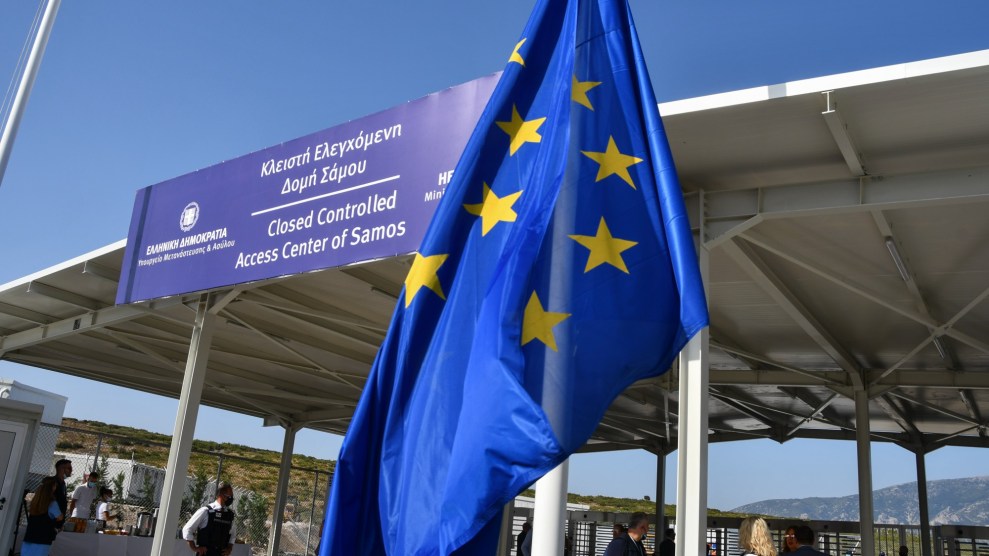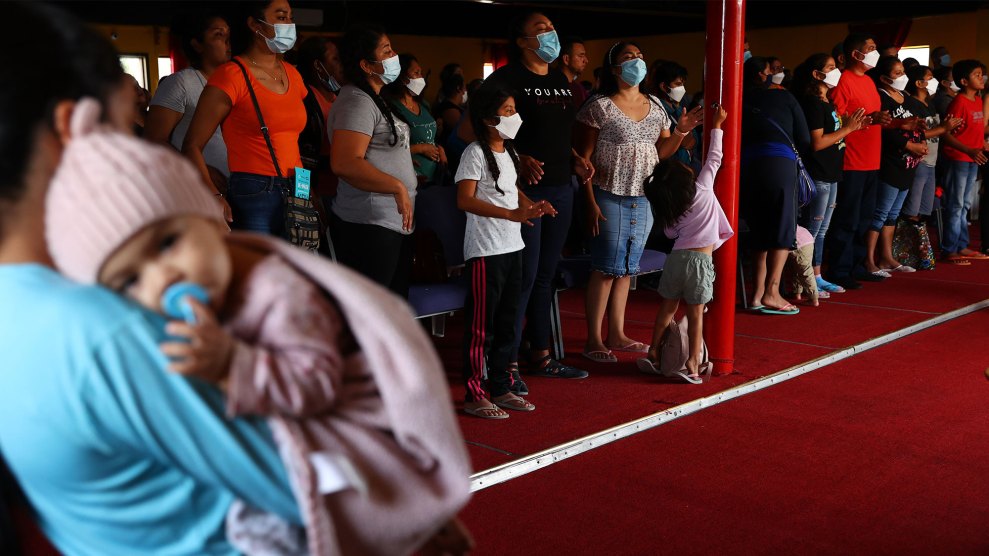
New multi-purpose reception and identification migrant center on the island of Samos, Greece.Michael Svarnias/AP
Thousands of migrants freezing in sub-zero temperatures in the forest along the Belarus-Poland border. A “shadow immigration system” that throws asylum seekers into militia-run prisons in Libya to prevent them from reaching Europe. Cubans being violently pushed out of Greece and into Turkey. “We are in the age of walls and barbed wire,” Pope Francis said during a recent visit to a refugee camp in the Greek island of Lesbos. “Let us stop this shipwreck of civilization!”
Reports of increasingly tight border restrictions hardly paint a picture of the old continent as a beacon of refuge for vulnerable people seeking safety these days. But faced with its own set of challenges at the US-Mexico border, the Biden administration is looking for inspiration from Europe on how to better receive and process asylum seekers.
Earlier this week, the Washington Post reported that government officials are considering proposals for border reception centers similar to the ones that popped up in countries such as Germany, Switzerland, and Sweden between 2015 and 2016 in response to the arrival of large numbers of Syrian, Afghan, and other asylum seekers. Under this model, migrants would stay in a “non-carceral setting with access to recreation and educational programming, medical services, and legal counsel” while their asylum cases are reviewed. If they failed to qualify for protection under the law, they would be deported. “We’re still in the concept development phase, but as we move into year two of this administration, there will be a real focus on truly bringing about meaningful reform to our asylum system and how we process asylum seekers at the border,” one official told the newspaper.
Some immigration experts and advocates received the news with a dose of skepticism and caution.
When is a jail not a jail? When it's a "non-carceral reception center" that comes with an ankle monitor and threat of arrest if you leave before you can be deported. https://t.co/5U4dvuDp2i
— David Bennion (@dcbennion) December 14, 2021
Mother Jones spoke with Yael Schacher, a senior US advocate at Refugees International and author of a forthcoming book about the history of asylum in the United States, about what reception centers in Europe look like and what practices, if any, the United States should be borrowing from them:
According to the Washington Post, Biden administration officials are looking to reception centers for asylum seekers in Europe as a model. What do you make of that?
My inclination is to say that we need some fresh ideas on how to handle the large number of asylum-seeking families at the border and there are some good models in Europe, but most of them have problems as well. One major flag for me was the fact that some of the models that they’re looking to not only do they have some problems, but they’re not frontline states. Germany, for example, is not the first country that people arrive in. They did have a lot of numbers when the Syrian refugee movement happened in 2015 and 2016, but for the most part, Germany does not receive numbers nearly comparable to what we have at the (US-Mexico) border, where you have 5,000 to 7,000 people coming a day.
The frontline states of Europe, places like Greece or Spain, are actually moving towards much more punitive forms of reception, closed-controlled access centers. The condition for migrants on the Greek islands got a lot of attention for being atrocious and as a result, the Greek government is setting up these five multi-purpose centers to receive asylum seekers, but they look a lot more like prisons. There’s surveillance, barbed wire, and it has round the clock security by a private security company. Camp residents are subject to security checks on reentering the site and NGO workers have said that children as young as 10 are being searched thoroughly before being allowed back in after school. Conditions in some ways are better than they were in these squalid refugee camps, but certainly it’s a detention model for housing asylum seekers. And the entire European Union is funding Greece because it’s a frontline state to basically warehouse people in Greece and prevent them from coming further into Europe.
I worry that perhaps the fact that the United States is comparing itself to Germany rather than Spain or Greece might indicate that the Biden administration is also planning on making a safe third country agreement with Mexico so that we become more like Germany and less a frontline state. We would make Mexico receive people and we would only take those who could prove that Mexico was truly unsafe for them to resettle. But right now, we’re more like Greece and Spain.
What have been some of the successes and shortcomings of the various European reception centers?
Some of the European models—like in Switzerland and Germany—are based on the idea of not keeping people concentrated in one place but dispersing them around the country. They’re relatively small; not that many people are in each one because otherwise they become massive warehouses of people. But some of these are in relatively remote places, so you’re sort of left isolated, and their conditions vary. In Germany, they tend to concentrate different nationalities of asylum seekers in different reception centers so different nationalities tend to have different conditions—some better, some worse. These countries also provide asylum seekers with a financial stipend.
People stay in these reception centers for a couple of months, and they are usually allowed to leave during the day and come back at night. The stays are quite long because the adjudication on the asylum claim is done while you’re living in the reception center. Sweden has a better model whereby you do an initial registration and people are assigned a caseworker, but then you’re sort of placed relatively quickly into the community. The reception center is, short-term, more akin to the way we treat unaccompanied minors [in the United States], where we ideally send them to a shelter for a very short time and then they’re released to a sponsor or to the community where they get post-release services. It’s been pretty successful even in terms of people who have been denied asylum: About 70 percent of them comply with leaving the country at the end of the process, which is pretty good considering it’s such an open system.
Many immigration experts seem skeptical of the viability of such models in the United States, with some saying it could easily turn into “kids in cages” and family detention 2.0.
I think the devil is in the details right now, and the details are missing. There are many issues like access to counsel, access to services, freedom of movement, and how long people are going to stay in these centers. I don’t think any of them are at the scale of what we’ll have to deal with at the border here and all of them have both positives and negatives. I’m not saying don’t look to Europe, but think carefully about how we can do this to scale given how many people come to the United States. The question is, can we do the kind of reception and integration programs at the scale that we need to? That’s the real challenge. I’m a little worried that it’s going to end up being closer to a family detention model.
What a lot of us in the advocate community would hope for is a humane system that really moves away from a carceral model. A system that would provide access to case management and legal services right away and that should not be controlled by Customs and Border Protection (CBP), because it risks devolving into the sort of tent facilities we’re used to seeing in Texas—or into relatively long stays in these reception centers if adjudication needs to take place while they’re there instead of after release. I want us to be selective and thoughtful about how to use these models.
It sounds like this would have to come hand in hand with changes in the way asylum cases are adjudicated, since immigration courts are so backlogged.
The Department of Homeland Security and the Justice Department put out a proposed rule that would put a lot of the asylum adjudication of people coming to the border in the hands of asylum officers rather than the overloaded immigration courts. The only problem is that there’s a tremendous backlog in our asylum office, too. We would need a lot of money and have to devote a lot more resources to the training of asylum officers and hiring many more officers to make that not get immediately backlogged as well.
Are there any lessons that can be drawn from the recent experience of receiving Afghan evacuees?
The military and DHS frequently referred to Afghans on the [military] bases as guests, which is so different from how they talk about asylum seekers who are presumed to be removable. If only we could think of asylum seekers at the border as guests and treat them as such with hospitality. The federal government did so much to create a welcoming environment for the Afghans—interagency task force, a special envoy in charge. We would need a comparable effort for asylum seekers and to make these reception centers really welcoming and humane.
How do you reconcile that urge to look for a more humane reception model with the fact that this administration has brought back or kept in place very restrictive border policies like Remain in Mexico and Title 42? Does it strike you as a calculus to perhaps appease critics and advocates?
I think the Biden administration has made a lot of promises to create a humane asylum system in our country. The first executive orders were about that. There’s a lot of strategizing about what some ideal system that eventually is going to be created, that’s going to be humane, and it’s going to be efficient and remake our asylum system in some indefinite future. But right now, on the ground, we’re not seeing any of it. To most advocates, it seems it’s on paper only. It seems hollow when the reality is just literally no asylum at our border. There’s a divide in the [Biden] administration on immigration issues. Some people want to create a truly humane system building on the best that Europe has to offer. And some people basically just want detention. What are we going to get? Which side is going to win? In the end, a lot of the people who are more hardliners are winning out.












